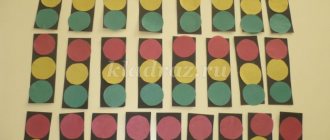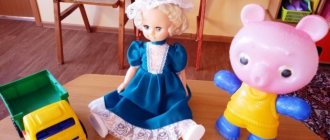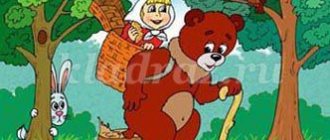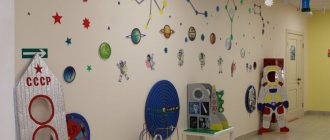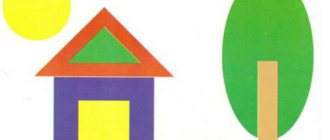Open lesson on rhythmics in the preparatory group
Elena Zubrova
Open lesson on rhythmics in the preparatory group
Methodological association
music directors
Nevsky district
on this topic:
«
Musical and rhythmic movements"
Compiled and conducted
music director of GDOU kindergarten No. 142
Zubrova Elena Konstantinovna
St. Petersburg
December 10, 2008
Rhythm lesson
Goals:
• Promote the comprehensive aesthetic development of children.
• Activate children's musical perception through movement, instill in them the skill of a conscious attitude towards music, and help identify their musical and creative abilities.
• Psychological emancipation of the child through the development of his own body as an expressive (“musical”) instrument.
Tasks:
• Development of the ability to perceive music, that is, to feel its mood and character, to understand its content;
• Development of special musical abilities: ear for music, musical memory, sense of rhythm;
• Development of musical horizons and cognitive interest in the art of sounds;
• Development of dexterity, accuracy, coordination of movements;
• Development of flexibility and plasticity;
• Formation of correct posture, ability to navigate in space;
• Enrichment of motor experience with various types of movements;
• Development of creative imagination and fantasy;
• Development of the emotional sphere;
• Formation of a sense of tact and cultural habits in the process of group communication with children and adults.
Progress of the lesson:[/ i]
With a calm step, the children walk into the hall to their seats (letter “p”).
They bow and greet. "Waltz" (fragment). Music by Ts. Kozlovsky.
First part . Basic movements.
1. “Girls and boys are walking.”
Music by V. Zolotarev, movement by I. Lifits (cassette “Let’s run and jump” No. 4, art. A)
Teach children to move rhythmically and clearly in the character of music; perform movements, then one by one (first the outer circle moves, then the inner one, then together (in pairs in a circle, keeping a distance. At the end - a clear stop.
2. Walking with a stop.
"Ecosaise". Music by F. Schubert.
Develop the ability to listen to music and maintain balance during an unexpected stop or braking.
3. Running with clapping.
“The Game of Blind Man's Bluff” from “Children's Scenes” by R. Schumann
Teach children to move in a circle, jogging lightly, while clapping their palms.
4. Walking with a springy step.
“Chimes” (excerpt). Music by V. Shcherbachev
Convey the character of a gentle, quiet melody, moving with a light springy step in a circle.
5. Walking with an extended step.
Russian folk song. “Will I go, will I go out.”
Master the side step (left - left - and - right - right). The movement is performed on a “spring”. It is recommended to repeat this exercise systematically with children of all ages, as it is the main dance movement.
6. Easy running.
Polish folk melody. Arranged by T. Lomova
Children move in a circle with a light dance run (with a feeling of three-beat size).
The driver, standing in the center of the circle, marks the strong beat of the beat with a clap.
7. "March". Music by A. Grechaninov
Clearly, rhythmically perform jumps (alternating “feet apart shoulder width apart” with a “feet together” jump). In the second part, an energetic step with high leg lifts alternates with a spring step, in accordance with the change in dynamics.
8. Walking, jumping, stopping.
"Etude". Music by F. Burgmuller
Listening to music, children learn to convey the change in its rhythm with their foot movements.
9. Springs.
Hopak from the opera “Sorochinskaya Fair”. Music by M. Mussorgsky.
Perceive the cheerful, playful nature of the dance melody. Note the dynamic shades of music in movement, more clearly – accents.
Move from light “springs” to more energetic movements (jumping).
10. Jumps - side gallop.
Fragment from Hungarian Rhapsody No. 2. Music by F. Liszt.
Teach children to perceive a two-part (non-contrasting) form. In accordance with the change of parts, move with light hops, side gallop (face - back in a circle).
11. Walking on half toes.
Excerpt from the opera “Don Giovanni”. Music by W. Mozart.
This exercise helps you master walking on your toes. There is almost no vertical oscillation; movement is smooth, continuous.
12. Run light and strong
"Ecosaise". Music by F. Schubert, movement by S. Rudnev.
Teach children to respond to dynamic changes by changing the direction and nature of movement. Improve spatial orientation. Strengthen the skill of alternately performing movements. (One subgroup performs a rapid run, the other marches in place, then vice versa).
Second part. Hand exercises.
Gymnastic exercises without objects.
1. Exercise “Strong Arms”.
"A boring story." Music by A. Grechaninov.
Develop attention to music. Change the position of your hands according to musical phrases. Feel the different states of your arms and body (strong, collected and relaxed).
2. Exercise “Soft hands”.
"Landler". Music by F. Schubert.
Improve hand plasticity. Pay attention to dynamic shades and, in connection with this, the wall of movement. When clapping, keep your head and body straight.
3. Leg bending and swinging exercise.
"Ecosaise". Music by F. Schubert.
Teach children to perform movements clearly and rhythmically. Correlate the volume and amplitude of movements with dynamic changes in music (“f” loudly – throwing movements, “r” quietly – relevé, lifting onto half-toes.)
4. “Singing hands.”
“The Organ Grinder Sings” (excerpt). Music by P. Tchaikovsky.
To convey the gentle, dreamy melody of the music, with such melodious, smooth movements, as they would perform it with the sound of their voice.
5. "Little commander." Music by S. Maykapar.
Convey the cheerful, decisive character of the play in movement. (Batman - tandu, demi - plie, releve)
6. "Minuet". Music by S. Maykapar.
“Sing” the music with your hands, making sure that the accented strong beat stands out in your movements.
7. Exercise. Music by A. Zhilinsky.
Perform half squats and deep squats in accordance with musical phrases. Monitor the position of the body.
8. "Moth". Music by S. Maykapar.
Convey the light, reverent nature of the music with hand movements (moth wings).
9. Dance of the maidens in Naina's castle. From the opera "Ruslan and Lyudmila". Music by M. Glinka.
Perform movements gracefully, flirtatiously, playfully; Make sure that the toe of the working leg is pulled back.
10. Circular movements with the hands.
"The leaves are blooming." (Excerpt from "Gallop") Music by J. Meyer.
Improve the plasticity of the hands (especially the hand).
11. “The wind is blowing at the gate.” From the music to the drama “Prince Kholmsky”. Music by M. Glinka.
Convey the character of Russian dance in movement.
12. Smooth hand movements.
Excerpt from the play “Slavic Dance”. Music by A. Dvorak.
Smoothly raise and lower your arms in accordance with musical phrases.
13. “Sketch.” Music by K. Cherny.
Perform musically. Hand movements imitating the movements of “wings”, “antennae”, “flower” reaching towards the sun, must be changed in accordance with the phrasing of the play.
14. “Music box.” Music by S. Maykapar.
Easily and gracefully perform the simplest waltz movements.
The third part . Musical and rhythmic games.
1. "Passacaglia". Music by G. Handel
Conduct musical exercises to improve the ability to move in the character of a musical piece.
Listen to the play, determine the number of its constituent parts and their nature.
First part. Walk at a calm pace.
Second part. Move in leaps.
The third part. Walk with a stomping step.
2. "Children's play." Music by S. Maykapar.
Stand in four (two) lines. One line shows a movement, and the one standing opposite must repeat this movement. The movements should correspond to the character of a light, graceful polka. The game continues until the supply of moves runs out.
3. “Dance like me!”
"Polka - pizzicato." Music by I. Strauss.
Teach children to perform dance elements of their choice and create various combinations of movements. Clearly perform a rhythmic pattern with clapping.
Fourth part. Dance compositions.
Dance composition with gymnastic ribbons.
"Waltz" (abbreviated). Music by T.V. Sviridov. From musical illustrations to A. S. Pushkin’s story “Blizzard”.
Improve your tape technique. To convey in motion changes in the character, dynamics, and texture of individual parts of a musical work.
Children perform a final bow. "Waltz" (fragment). Music by Ts. Kozlovsky.
To the calm music of “Prelude” by G. Bertini, the children leave the hall.
Literature:
.
i G. Franio “The role of rhythm in the aesthetic perception of children”, Moscow, “Soviet Composer”, 1989
2. A. Lugovskaya “Rhythmic exercises, games and dances”, Moscow, “Soviet Composer”, 1991.
3. G. Franio “Lesson plan on rhythm for preschool groups of music schools and art schools,” Moscow, 1993
4. G. Franio, I. Lifits “Methodological manual on ri, 1995
5. Stefanida Rudneva, Emma Fish “Musical Movement”, Publishing House, St. Petersburg, 2000. Edited by V. T. Tsarkova.
6. A. I. Burenina “Rhythmic mosaic” (Rhythmic plasticity program for children, St. Petersburg, 2000
7. T. F. Koreneva “Musical and rhythmic movements for children of preschool and primary school age.” In two parts, Moscow, Vlados, 2001.
8. Nina Berger “Rhythm First” (Educational and methodological manual) Publishing house “Composer”, St. Petersburg, 2006.
Summary of lessons on rhythm for children of senior preschool age.
Summary of a lesson on rhythm in the preparatory group “Multi-colored caps”
Purpose of the lesson:
development of the motor sphere of children, formation of spatial orientation skills, development of imagination and the ability to motor improvisation.
Tasks:
1. Develop spatial orientation skills. 2.Develop attention, memory, creative imagination. 3.Overcome motor automaticity. 4.Develop the visual and motor response of children to light, verbal, visual signals. 5. To foster children’s independence in performing exercises Equipment: tape recorder, piano, audio cassettes with recordings, flashlights, cards with diagrams, sun mat, chest, gnome hats. Children's musical instruments: bells, rattles, bells, maracas
Progress of the lesson:
Children enter the hall to the music and stand in two columns - boys and girls. Greetings and bows. Teacher. Today I invite you to go to a fairy tale. Now you and I will fly to the music. If the music stops, it means there is some kind of obstacle on the way. You will see the diagram and line up the same way.
Exercise on rearranging in space
Children move loosely in accordance with the musical accompaniment (light running, jumping). With the end of the music, they are built in accordance with the diagram (circle, column, 2 circles, 2 columns) Teacher. Guys, look, we are visiting some fairy-tale characters. I will help you. Listen to the riddle. The rainbow has exactly seven colors, And music has seven notes, Well, in this fairy tale there are seven different gnomes. But look, there are no gnomes, only their caps are here. Yes, they are all different colors! Why do you think? (probably because gnomes have different personalities) Oh, and there’s a note here. Reads: “Our caps are magical. If you put the cap on, you can find out who its owner is. Only the one who eats the magic candy can find out what the caps say.” Since there is only one candy, and there are many of us, let Olga Alexandrovna eat it. (the teacher eats the candy and puts on the first cap) Teacher. This cap (red) is worn by the gnome Veselchak. He loves to play fun games. So we're going to play now.
Game "Remember the movement"
Children line up in two lines. The teacher and the children determine what movements they will perform for each count: 1, 2, 3, 4. Then, to the music, they perform the movement at the teacher’s command. In order, in reverse order, out of order. Teacher. Whose cap is next (orange)? Educator. This is the big gnome. He takes great care of his health. How can you monitor your health? Teacher. We will also give you a massage now.
Game self-massage
Children sit on the floor. Yes, yes, yes, yes, rub your hands together. It's getting cold. Yes, yes, yes, yes, they gently stroke the neck from top to bottom with their palms. The water turned to ice. Doo-doo-doo-doo massage the wings of the nose. I slipped on the ice. Doo-doo-doo-doo rub their ears with their palms. I'm going skiing. Dy-dy-dy-dy put your palm to your forehead with a “visor” and move There are footprints in the snow Dy-dy-dy-dy stroke your stomach clockwise Where to find food in the forest Di-di-di-di stroke your feet You walk in the snow . Teacher. It's probably time to find out who's next (green cap)? Educator. This is the gnome Grumpy. He grumbles at the dwarves if they don't come home on time. To call them, he signals with a flashlight. Let's also play with a flashlight.
Game with lanterns
Children move to different types of music, depicting a playful image with their movements (the gnome is cheerful, sad, cheerful). During the music, the flashlight starts flashing. We need to gather around him. Teacher. We put on the next cap (blue). Educator. This is the gnome Dancer. Every evening he gathers the gnomes and learns dances with them. Teacher. Now we will dance too.
"Dance of the Dwarves"
Teacher. Here's the purple cap. Educator. It is worn by the gnome Tanya. He loves to sleep very much, and the other gnomes, so as not to disturb him, try not to make noise. Teacher. Dwarves love to play musical instruments, but at the same time they try not to wake Tanya. We will play a game with you.
“Who will pass the musical instruments more quietly?”
Children line up in two columns, each team has a set of noise instruments: tambourine, maracas, bells, rattle, bell. You need to pass the tools to each other, the latter puts them in a line. Whose team transmits faster and more quietly plays to the music with their own orchestra. Teacher. Now the next cap (blue). Educator. Dwarf Naughty. He loves fun outdoor games! Teacher. I even know what game we can play with you.
Game "Centipede"
Children line up in two columns and perform movements according to the text. A fast centipede rushes along the path in the morning. - While standing, move their hands. She knocks loudly with her feet. She is in a hurry for business. - They stomp with their right foot. She got caught on a stump, shook her hands and raised forty legs. - Raise their hands up. Hee-hee-hee yes ha-ha-ha, po - 3 claps on the right and left. That's nonsense. — Place their hands on the shoulders of the person in front. Then, to the music, they move like a train in any direction. They fall and crumble. When the music ends, they must stand up and quickly find their place. Teacher. All the caps are gone, which means the fairy tale is over. Which gnomes left their caps? (Children list) Don't they remind you of anything? That's right, a rainbow. But it seems to me that some color (yellow) is missing here... Yes, the gnome Baby wears a yellow cap and he always forgets to take it off. But look, instead of a cap, he left us the sun, which will help us return to kindergarten. What is it like? (children's answers: warm, affectionate, gentle, bright) Now lie down with your head in the sun. Imagine that you are his rays. The gentle, kind, gentle warmth of the spring sun spreads throughout your body.
Relaxation to music
Teacher. I ask you to line up to bow. What did you like about the lesson? (Children's answers). Bow. Children leave the hall to the music.
Bibliography:
1. Alyabyeva E. A. Correctional and developmental classes for children of senior preschool age. M., 2002. 2. Burenina A.I. “Rhythmic mosaic” Program on rhythmic plasticity for children of preschool and primary school age - 2nd ed., revised. and additional - St. Petersburg: LOIRO, 2000. 3. Gogoleva M. Yu. collection. “Logoritmics in kindergarten” Publisher: Academy of Development. 2006. 4. Kolodnitsky G. A. Musical games, rhythmic exercises and dances for children. Publisher: Gnom-Press 2007 5. Plaksina L.I. Kindergarten programs. Corrective work in kindergarten. M., “City”, 19 6. Chistyakova M.I. Psycho-gymnastics. M., 1990.
